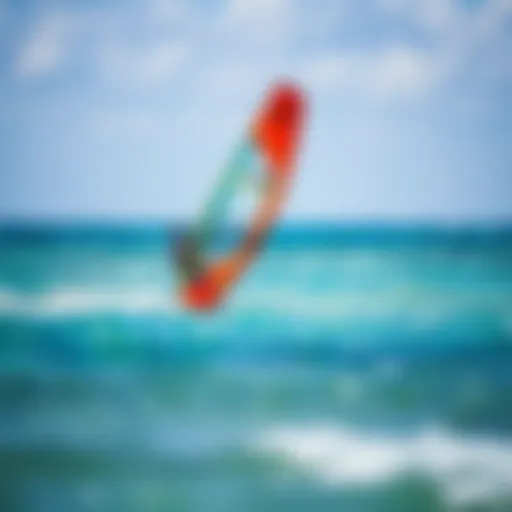Essential Guide to Surfears Ear Plugs for Kiteboarders


Intro
Engaging in water sports like kiteboarding demands not only skill but also the right gear to ensure a safe experience. One often-overlooked aspect of water sports is ear health. With the relentless spray of water and wind, our ears can suffer, leading to discomfort and potential long-term issues. Here enters Surfears ear plugs—designed specifically for water sports enthusiasts. This guide delves into the significance of ear protection, the unique attributes of Surfears, and how they can improve your kiteboarding experience.
Techniques for Kiteboarding Enthusiasts
Kiteboarding is as thrilling as it is challenging. To maximize enjoyment and safety, mastering technique is crucial. Here, we look at various techniques catering to both beginners and seasoned kiteboarders.
Beginner Techniques
For those just embarking on their kiteboarding journey, there’s a world of skill acquisition to dive into. A solid foundation is like setting the anchor before casting your lines.
- Balance and Stance: Start with learning to align your body over the board while keeping your knees slightly bent. This visualizes surfacing smoothly, just like gliding over the water surface.
- Control of the Kite: The kite serves as your propulsion. Understanding how to manage its position in relation to the wind is paramount. Think of it as juggling; maintaining the kite’s position relative to wind direction without letting it crash is step one.
- Body Dragging: Before you fully embrace the board, getting comfortable with body dragging in the water helps in feeling the kite’s pull without the added complexities of balancing on a board.
Advanced Maneuvers
After grasping the fundamentals, it’s time to level up your game. Mastering advanced techniques can elevate your performance and make you stand out on the water.
- Jumping Techniques: Getting air is the ultimate thrill. Learning how to load up the kite before a jump, and how to spot your landing can lead to spectacular aerial feats.
- Transitions: Switching directions smoothly while maintaining speed can be a beautiful aspect of riding. A sharp turn needs good edging and a keen sense of balance—imagine dancing on the water.
- Tricks and Stunts: This is where creativity shines. Whether it’s a board grab or a kite loop, these maneuvers require commitment and finesse. Practicing in a safe environment is key to developing the right stabilizing moves.
Why Ear Protection Matters
In the excitement of kiteboarding, ear protection often gets shoved to the backseat. However, constant exposure to wind and water can lead to a myriad of issues, such as ear infections and even hearing loss.
Surfears ear plugs offer a solution, allowing kiteboarders to enjoy their rides without compromising their ear health. With their unique design, they prevent water entry while retaining essential sounds like fellow riders and natural elements.
As kiteboarding gains popularity worldwide, the educational importance of ear safety shouldn’t be underestimated. Enriching the overall experience hinges on understanding the best practices, and protecting one’s ears is undoubtedly part of that equation.
Practical Applications of Surfears
Using Surfears involves more than just inserting the plugs into your ears. Here are some practical aspects to consider:
- Fitting: Make sure they fit snugly. A good seal can mean the difference between a great session and constant discomfort.
- Maintenance: Just like your kite and board, your ear plugs need care. Clean them regularly to ensure longevity.
- Usage: When rigging your gear, pop them in before hitting the water. This proactive approach ensures ear safety ahead of the fun.
The End
"An ounce of prevention is worth a pound of cure."
For more information on kiteboarding techniques and gear reviews, check resources such as Wikipedia or discussions at Reddit.
Be sure to keep your gear in check and prioritize your ear health ahead of the next kiteboarding adventure.
Preface to Ear Health for Water Sports
In the world of water sports, few aspects are as critical yet often overlooked as ear health. Kiteboarding, in particular, exposes enthusiasts to wind, waves, and splashes that can wreak havoc on ear well-being. Understanding the importance of ear protection is not just an afterthought; it’s vital for enjoying the experience and performing optimally.
The Importance of Ear Protection
When you’re kiteboarding, your ears are continuously at risk. Water entering the ear canal can lead to infections such as swimmer's ear or, in more severe cases, hearing loss. Protecting your ears with the right gear, like Surfears ear plugs, can make all the difference. Not only does it prevent unwanted water entry, it also keeps your ears dry, reducing the risk of infections and ensuring you can focus on enjoying your ride.
Additionally, ear plugs help filter out the background noise of crashing waves and howling winds. This allows you to better hear your surroundings and any instructions from your instructor, enhancing overall safety on the water. When you can hear clearly, you’re more likely to react swiftly to changing conditions or potential hazards.
The quick takeaway? Using ear protection is crucial for maintaining ear health, ensuring safety, and improving your overall kiteboarding experience.
Common Ear Problems in Water Sports
Engaging in water sports without proper ear protection can lead to a variety of common ear problems:
- Swimmer's Ear: This painful condition occurs when water remains trapped in the ear canal, leading to an infection. Symptoms can include itching, redness, and drainage from the ear.
- Barotrauma: Changes in pressure while diving or jumping can affect ear health. It may cause discomfort or hearing issues, also leading to a temporary loss of hearing.
- Earwax Compaction: Water can push cerumen deeper into the ear canal. This can lead to blockages, leading to hearing loss or discomfort.
It's critical to recognize these potential problems so you can take proactive measures. Investing in effective ear protection, such as Surfears ear plugs, is an excellent first step in safeguarding your ears while enjoying water sports. Just remember, your ears are not just vital for hearing; they play a significant role in balance and spatial orientation as well, which are essential during kiteboarding.
"An ounce of prevention is worth a pound of cure." – Benjamin Franklin
In summary, prioritizing ear health in water sports can save you from long-term issues and ensure your kiteboarding adventures remain safe and enjoyable.
Overview of Surfears Ear Plugs
Understanding the overview of Surfears ear plugs is critical for anyone looking to enhance their kiteboarding experience. These ear plugs are not just any ordinary water protection devices; they are specifically tailored to cater to the needs of kiteboarders, providing a blend of comfort, functionality, and water safety. In a sport where water exposure is inevitable, the effectiveness of these ear plugs can greatly influence both performance and safety.


Design and Materials
The design of Surfears ear plugs is a well-thought-out amalgamation of practical considerations and cutting-edge technology. They are usually crafted from high-quality silicone, making them both durable and flexible. This material not only provides a tight seal to keep water out but also ensures that they can be comfortably worn for extended periods.
Moreover, the ear plugs often feature an ergonomically molded shape, which follows the contours of the ear canal. This thoughtful design minimizes discomfort, a feature that’s a hit among kiteboarders who might spend hours riding the waves. The porting systems integrated into the design allow for water to stay out while still enabling fluctuations in pressure, an important aspect when diving into the waves.
Using materials that are free from harmful chemicals is also a plus. Kiteboarders can feel assured that these ear plugs are not only effective but also safe for prolonged use. Overall, the combination of thoughtful design and quality materials leads to a product that's well-suited for any kiteboarding enthusiast.
Unique Features
What sets Surfears apart from the competition are the unique features that specifically address the challenges faced by water sports enthusiasts. First and foremost, they often come equipped with a patented valve mechanism that regulates pressure inside the ear. This feature is particularly vital when kiteboarding, as the rapid movement through water can create pressure changes that may be uncomfortable without proper regulation.
Additionally, the easy-to-use and adjustable tether system ensures that they remain secure, even in the most robust of conditions. This means less worry about losing them mid-ride or getting debris stuck in your ears while riding high waves. Kiteboarders can focus on their performance instead of being preoccupied with ear safety.
Furthermore, many users highlight that Surfears ear plugs maintain sound clarity, allowing kiteboarders to hear wind patterns or directions from coaches, which is crucial for performance. This combination of functionality and safety sets Surfears ear plugs apart as a top choice for kiteboarders seeking the best balance of comfort and protection.
Benefits of Using Surfears Ear Plugs
When it comes to kiteboarding, ear protection may not be the first thing on your mind, but it holds significant value for every enthusiast or professional. The wind, waves, and splashes can expose your ears to water, which may lead to infections or discomfort. This section delves into the advantages of using Surfears ear plugs, giving you a clear idea of why they are an essential investment for those who share the affinity for kiteboarding.
Protection Against Water Exposure
One of the primary purposes of Surfears ear plugs is to keep water at bay. Water exposure not only messes with your comfort but can also give rise to various complications, including swimmer’s ear and other infections. Surfears ear plugs create a reliable barrier that prevents water from entering the ear canal while still allowing for a certain level of sound transmission. This is particularly crucial when you're out on the water, navigating your way through gusty winds and crashing waves.
- They effectively block water while ensuring you stay aware of your surroundings.
- Surfears ear plugs are designed to fit snugly, minimizing the risk of them falling out during intense activities.
- The plugs are made from materials that won’t irritate your skin, making them ideal for prolonged use.
By ensuring your ears stay dry, you reduce the chance of developing painful infections, thus keeping your adventures on the water uninterrupted.
Enhancing Comfort During Kiteboarding
Comfort is paramount when engaging in any sport, and kiteboarding is no different. Surfears ear plugs significantly enhance your comfort level in challenging conditions. With the wind whipping around and waves crashing, the last thing you want is the irritability of water or wind in your ears.
- The ergonomic design helps to minimize the pressure inside the ear, providing a comfortable fit.
- They are lightweight, so you won’t even feel like you’re wearing them after a while.
- These ear plugs reduce wind noise, helping you concentrate better on your kiteboarding techniques and strategies.
Kiteboarding involves precision and focus, and minimizing distractions like discomfort in your ears can make a notable difference in your performance, especially during competitive heats.
Improved Hearing Underwater
It may sound counterintuitive, but Surfears ear plugs enhance your hearing experience while you're submerged. The design aims to balance sound frequencies, allowing something of a “natural hearing” experience even when you’re underwater. Such a feature is a game-changer for kiteboarders who might need to communicate or respond quickly while in the water.
- Users often report a better ability to hear instructions or guidance when practicing maneuvers.
- The ear plugs allow for sufficient sound transmission, which can be vital for safety in certain scenarios.
- This improved hearing can help you become more attuned to your environment, paving the way for an enriched aquatic experience.
Equipped with Surfears, you won’t lose the ability to hear critical sounds that could affect your riding, even as you navigate through aquatic elements.
Investing in quality ear plugs isn’t just about comfort; it’s about maintaining your overall ear health and ensuring you can enjoy kiteboarding to its fullest without unwanted interruptions.
Comparative Analysis: Surfears vs. Other Ear Plugs
When it comes to ear protection for kiteboarding, it's essential to consider the diverse options available on the market. In this section, we will delve into how Surfears compares with other ear plugs, focusing on key characteristics like material types, fit, comfort, and overall effectiveness for kiteboarders.
Silicone vs. Foam Ear Plugs
Silicone ear plugs have become popular among water sports enthusiasts due to their flexibility and durability. They are often designed to keep water out while providing a decent level of comfort. On the other hand, foam ear plugs typically offer better noise insulation and a tighter seal, but they can be uncomfortable for prolonged use, particularly when submerged in water.
- Silicone Ear Plugs:
- Foam Ear Plugs:
- Advantages:
- Disadvantages:
- Flexible and easily molded to fit different ear shapes.
- Resistant to water breaking down the material.
- Reusable after cleaning.
- May not block sound as effectively as foam.
- Can slip out if not properly inserted.
- Advantages:
- Disadvantages:
- Excellent noise cancellation, which can be useful in reducing distractions.
- Generally affordable and easy to find.
- Can become soggy if exposed to water repeatedly, losing effectiveness.
- Might cause irritation during extended wear.
Ultimately, the choice between silicone and foam largely hinges on personal preference and specific water sport needs. Kiteboarders looking for flexibility and durability might lean towards silicone, whereas those prioritizing sound insulation may prefer foam.
Custom-fit Ear Plugs


For kiteboarders serious about their ear health, custom-fit ear plugs present a compelling option. These plugs are molded precisely to the user’s ear, offering a snug fit that can block water while minimizing discomfort. Here’s how they stack up against standard options:
- Benefits of Custom-fit Ear Plugs:
- Considerations:
- Tailored Comfort: Since they’re specifically made for your ears, they are less likely to cause irritation or fall out during intense activities.
- Enhanced Performance: A secure fit allows for better water and noise insulation, which can significantly improve focus during kiteboarding.
- Cost: Custom-fit options are generally pricier than standard foam or silicone plugs.
- Time and Accessibility: They require a mold-making process, which takes time and may not be readily available at all locations.
"A good fit isn’t just about comfort; it’s about preventing potential health issues down the road. Investing in quality ear protection pays off in the long run."
For additional insights on ear health and protection, consider checking out resources like Healthline and CDC for expert advice on maintaining your ear health while enjoying water sports.
How to Choose the Right Ear Plugs for Kiteboarding
Choosing the right ear plugs is a crucial step for kiteboarders looking to maintain their ear health while enjoying the waves. Not all ear plugs are created equal, and understanding the unique needs of kiteboarding can significantly influence one’s overall experience on the water. Factors such as fit, material, and specific features should weigh heavily in the decision-making process, allowing kiteboarders to enjoy their sport without unnecessary discomfort or harm to their ears.
Understanding Individual Needs
Before diving into the sea of options for ear plugs, it’s vital to recognize that every kiteboarder has unique needs based on their style, environment, and frequency of use. Some may prefer to use their ear plugs every time they hit the water, while others may only need them occasionally. Additionally, consider the following:
- Frequency of Use: A daily kiteboarder may seek durable, high-quality plugs designed for long-term use, while a casual user might prioritize affordability and ease of access.
- Sensitivity to Water: Some kiteboarders may have heightened sensitivity and should look for ear plugs designed specifically for maximum protection against water ingress.
- Noise Sensitivity: If the roar of the ocean or the wind tends to overwhelm you, opting for ear plugs with noise-canceling features might be beneficial, allowing for better focus during rides.
Taking the time to assess these factors can preclude issues down the road and help in selecting a pair that aligns with your personal kiteboarding needs.
Evaluating Comfort and Fit
Finding ear plugs that fit comfortably is paramount for kiteboarders. Poorly fitting plugs can cause distractions, discomfort, and even pain, detracting from the joy of the sport. Consider these tips when evaluating fit:
- Try Before You Buy: If possible, test the plugs before committing. Many reputable sporting goods stores allow potential buyers to sample item fit and feel.
- Material Matters: Ear plugs come in various materials, including foam, silicone, and custom-molded options. Each type offers different levels of comfort and fit. While foam can conform to the ear, silicone often provides a snugger fit but may not be as comfortable for long periods.
- Size Selection: Different brands offer varying sizes. A snug fit is important, but one that's too tight can create pressure. Pay careful attention to size guidelines from manufacturers to find the best match.
- Check the Seal: Ensure the ear plugs create a proper seal without causing discomfort. You’ll want water to stay out, but also want to maintain the ability to hear surroundings adequately.
- Long-term Comfort: If an ear plug feels irritating after just a few minutes, it might not be the right choice for long kiteboarding sessions. Look for designs that promote breathability and comfort on the water.
If you want to avoid the ire of discomfort during your ride, selecting the right ear plugs with a focus on personal fit and comfort will make for a much more pleasurable kiteboarding experience. Proper ear protection in this exhilarating sport is as important as mastering the waves themselves.
Practical Tips for Using Surfears Ear Plugs
When it comes to enjoying a session on the water, having the right gear can make all the difference. Surfears ear plugs serve as a vital accessory for kiteboarders seeking to protect their ears from water exposure while still preserving their hearing ability. This section aims to provide essential tips on how to effectively use Surfears ear plugs, ensuring they deliver maximum benefits during your kiteboarding adventures.
Proper Insertion and Removal Techniques
Getting the ear plugs in and out of the ears might seem straightforward, but there’s definitely a technique to it. Get it right, and your Surfears will fit snugly, keeping water out and allowing you to focus on your ride.
- Choosing the Right Size: Ensure you’re using the right size for your ear canals. Check the fit before you even get on the water; a poor fit is a fast track to a bad experience.
- Inserting the Plugs:
- Removing the Plugs:
- With clean hands, hold the ear plug between your fingers.
- Pull your ear gently upwards to widen the ear canal. This ensures the plug can slide in easily.
- Carefully insert the ear plug into the canal. Make sure it’s snug but not causing discomfort. You shouldn't feel pressure or pain.
- To take them out, gently pull your outer ear with one hand. This helps loosen the ear plug’s grip.
- With the other hand, grasp the ear plug and pull it out slowly. Don’t yank; you might accidentally cause injury.
These steps seem minor, but they can enhance your comfort while kiteboarding and prevent issues. A well-sealed ear plug will let you focus on your maneuvers without the annoying distraction of water getting in.
Maintenance and Cleaning
Keeping your Surfears ear plugs in tip-top shape is essential for longevity and hygiene. Just like you wouldn't wear the same shoes every day without a clean now and then, ear plugs need care after braving the waves.
- Rinse After Use: Always give them a rinse with clean water immediately after use. This removes salt, sand, and grime that could build up over time.
- Dry and Store Safely: After rinsing, let them air dry before storing them in a clean, secure case. This prevents mold and ensures they stay in good condition for your next session.
- Regular Inspections: Periodically check for signs of wear, such as cracks or deformities. If you spot any, it’s time to replace them. Damaged ear plugs won’t offer maximum protection.
Keeping your ear plugs clean not only prolongs their lifespan but also safeguards your ear health. Remember, your ears deserve the same care as the rest of your body.
"Taking care of your gear is part of the adventure; failure to do so diminishes your experience on the water."
By adhering to these practical tips for using Surfears ear plugs, kiteboarders can seamlessly merge protection and performance. Whether negotiating challenging winds or riding the crest of a wave, equipped ears can only enhance the experience.
User Experiences and Testimonials
User experiences and testimonials provide invaluable insights into the efficacy and practicality of Surfears ear plugs, especially for kiteboarders. These accounts reveal not only personal preferences but also highlight the real-world advantages of using these ear plugs in the chaotic environment of water sports. By tapping into the collective voice of actual users, aspiring kiteboarders can make informed decisions about whether Surfears ear plugs fit their needs.
Diverse Perspectives from Kiteboarders
The voices of kiteboarders resonate with variety, reflecting distinctive experiences and needs when it comes to ear protection. Some riders note that Surfears plugs significantly strong>reduce water entrystrong> during high-speed maneuvers, which they find crucial for comfort and performance. A kiteboarder from California shares:
"I used to feel uneasy every time I jumped. With Surfears, that fear is mostly gone. Water doesn’t rush straight in when I tumble. It’s a game changer."
Others appreciate the sound design of these ear plugs. Being able to hear their coach’s instructions clearly while mitigating the risks of water exposure is a common praise. A rider in Florida remarked:


"Not only can I hear my friends and coach when I'm out on the water, but my ears also stay dry. It’s the best of both worlds!"
These perspectives underscore the versatility of Surfears ear plugs. They cater to diverse scenarios—some kiteboarders emphasize the need for complete blockage, whereas others prefer a degree of sound permeability.
Expert Opinions
Hearing from experts adds another layer of credibility to the conversation around ear health and the benefits of Surfears ear plugs. Auditory specialists have consistently stressed the importance of protecting one’s ears in loud, wet environments. Dr. Sara Mitchell, an audiologist specializing in athletes’ health, noted:
"The ears are incredibly sensitive. Continuous exposure to water can lead to infections, not to mention performance hindrance. Surfears provide a reliable solution for athletes who spend extensive time in water."
Furthermore, industry professionals like surfing coaches advocate for ear plugs as an essential part of every water sports kit. An experienced kiteboarding instructor shared:
"A lot of kiteboarders overlook ear protection, thinking it’s unnecessary. But safe practices, like using Surfears, can improve focus and overall performance on the water. Staying alert is key."
Their insights encourage an ongoing dialogue about proactive ear care for water sports enthusiasts. Such expert endorsements only serve to reinforce the practical experiences shared by users, solidifying the role of Surfears ear plugs in enhancing both safety and enjoyment in kiteboarding.
The Impact of Ear Health on Performance
When kiteboarding, the harmony between body and environment often determines overall performance. The ears play a crucial role in maintaining this balance, influencing not only physical agility but also mental focus. From the moment you launch your kite to the thrilling descent over waves, clarity of sound and spatial awareness hinge on ear health.
Connection Between Ear Protection and Focus
Hearing is more than just receiving sound; it’s a critical part of situational awareness. Being able to hear the whistling wind, the rush of water, and the calls from fellow kiteboarders can shape how effectively riders react in dynamic environments. When ears are compromised, whether due to water exposure or underlying issues like swimmer's ear, the ability to concentrate diminishes.
- Distracted Mindset: A clogged ear or an ear infection can lead to discomfort and distraction. Instead of focusing on technique or upcoming obstacles, riders may be preoccupied with pain or irritation. This can reduce confidence and affect performance.
- Coordination and Responses: Riders rely on auditory cues, such as wind direction, for balance and control. When protection keeps water out while preserving sound quality, it enables quicker, more intuitive responses to conditions.
For instance, wearing Surfears ear plugs allows kiteboarders to safeguard their ears without sacrificing hearing crucial signals from the environment. The ability to maintain this auditory connection fosters a focused mindset, making for a more profound riding experience.
Long-term Benefits of Ear Health Awareness
Taking proactive steps to protect ear health isn’t just an immediate concern; it has long-duration payoffs. Many water sports enthusiasts overlook the consequences of neglecting ear safety, often leading to chronic problems down the line. Understanding the need for ear protection is a game-changer for kiteboarders aiming for longevity in the sport.
- Preventing Chronic Issues: Continuing to expose unprotected ears to water can lead to persistent infections, such as otitis externa (commonly known as swimmer's ear) or eustachian tube dysfunction. Regularly using ear plugs can play a pivotal role in avoiding these recurring issues.
- Sustained Performance: When ears remain healthy, kiteboarders can enjoy an uninterrupted relationship with their craft. Giving due attention to ear health means taking one less worry off the table, which allows them to focus solely on honing skills and enjoying their sport.
- Informed Choices for Future Generations: By adopting an ear health-first attitude, experienced kiteboarders can guide newcomers on the importance of ear safety. This advocacy can foster a safer environment for budding enthusiasts, preserving both their passion and their health.
"A small investment in ear protection can secure years of successful kiteboarding, free from the troubles of ear injuries.”
In summary, ear health undoubtedly correlates to performance outcomes when kiteboarding. Being mindful about wearing protective gear can make the difference between a mediocre outing and an exhilarating experience on the water.
Future Innovations in Ear Protection for Water Sports
The quest for optimal ear protection in water sports like kiteboarding is ongoing. As the industry evolves, so do the technologies and materials used in ear plug design. Future innovations could be game-changers, achieving not only safety but also enhancing the experience of athletes in demanding environments.
One of the primary considerations here is the integration of new materials that surpass traditional silicone or foam options. With advancements in polymer technology, we might witness the emergence of ear plugs that are both ultra-light and offer superior waterproofing capabilities. Such innovations would ensure that athletes can focus on their sport without the nagging worry of ear infections or discomfort caused by water exposure.
Advancements in Materials and Technologies
To understand how future ear plugs might evolve, it’s crucial to look at materials science. In recent years, researchers have been exploring composites that offer durability and flexibility. Imagine ear plugs that adapt to the shape of your ear canals while maintaining a firm seal against water. Furthermore, materials like thermoplastics or state-of-the-art hydrogel could make ear plugs more comfortable, promoting longer wear-time without irritation. This adaptability would be a direct response to the evolving needs of kiteboarding enthusiasts, who require reliable yet comfortable protection.
"The future of ear protection is not just about keeping water out; it’s about integrating comfort and performance for a seamless experience."
Furthermore, technologies such as smart sensors and acoustics might find their way into wearable ear protection. Imagine making use of ear plugs that not only block water but also allow for selective sound transmission, enabling users to communicate while maintaining some level of ear protection. This could revolutionize how kiteboarders engage with their surroundings, creating a balance between safety and connectivity.
Potential New Features for Enhanced Performance
Looking ahead, potential features that may enhance ear plugs for water sports include customizable fit options, enhanced noise cancellation, and even real-time health monitoring. For example, ear plugs could be designed to mold precisely to the user’s ear shape through a memory-foam technology or heat activation, ensuring a perfect fit every time.
Another innovation might involve integrating anti-microbial properties to prevent infections, which is a significant concern for kiteboarders. By introducing silver nanoparticles or other safe antimicrobial agents during the manufacturing process, water sport enthusiasts could enjoy both protection and hygiene in one product.
Additionally, offering ear plugs with built-in communication systems could allow kiteboarders to receive urgent alerts or instructions while on the water. This would not only safeguard their hearing health but also ensure that they remain aware of their environment.
In summary, as we look towards the future, the ear protection landscape is on the brink of exciting developments. With advancements in material science and technology, kiteboarders can expect products that not only protect their ears from water but also enhance their overall performance and safety on the water. Keeping an eye on these innovations is crucial for any kiteboarding enthusiast aiming to stay ahead of the curve.
Ending: The Significance of Ear Protection in Kiteboarding
In the realm of kiteboarding, ear protection is often overlooked, but its significance can't be brushed aside. Water sports enthusiasts frequently find themselves immersed in challenging conditions, where the ears can be vulnerable to water pressure and possible infections. The right ear plugs, like those from Surfears, serve as a barrier against such risks, ensuring that kiteboarders can enjoy their sport without compromising their ear health.
Summary of Key Insights
Throughout this guide, we've delved into various aspects of Surfears ear plugs, highlighting their unique design and multifunctional benefits. These ear plugs not only protect against water ingress but also enhance overall comfort while kiteboarding. The findings indicate that many riders experience less distraction from discomfort or potential ear problems, allowing them to focus better on their performance. Ultimately, effective ear protection is an investment into one's health and enjoyment in the water, crucial for those who spend long hours riding the waves.
"The quality of your ear protection is as important as the gear that keeps you up in the air."
Encouraging Safe Practices
It's paramount that kiteboarders adopt safe practices regarding ear health. Education about ear protection and recognizing the signs of ear issues can lead to better outcomes for riders. Practicing proper insertion and removal techniques for ear plugs can prevent damage to the ear canal and ensure optimal performance. Kiteboarders should also schedule regular check-ups with healthcare professionals to monitor ear health.
To move forward with safe habits, consider these tips:
- Choose High-Quality Products: Invest in ear plugs designed specifically for water sports, like Surfears, as they provide both comfort and functionality.
- Establish a Routine: Get into the habit of checking your ear plugs before each session, ensuring they are clean and fit properly.
- Listen to Your Body: If you notice discomfort or any changes in hearing, address these issues immediately with a professional.
- Share Knowledge: Educate fellow kiteboarders about the importance of ear protection to build a culture of safety within the community.
By prioritizing ear health, kiteboarders can significantly enhance their experience on the water. The combination of protection, comfort, and confidence allows them to chase the wind and waves without hesitation.















